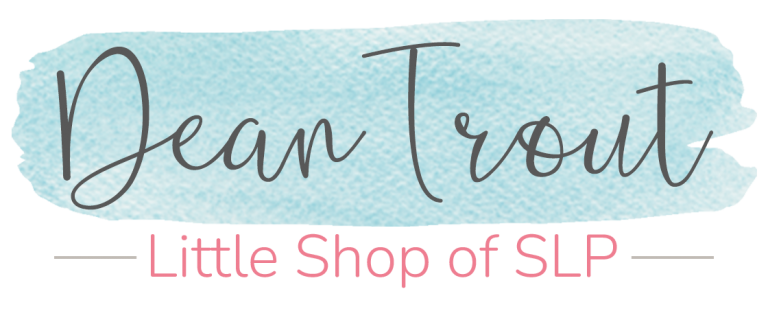The L sound is usually so easy to correct. It’s the “singing sound la-la-la-la-la.” Kids can pick up and imitate that so easily, right? For the most part, but it never fails one kid will come along who just cannot get the correct position. What do you do for that child? Today I will share my best tips on how to elicit /l/.
TIP #1: Jaw Stability and Segmentation
The child must have good stability of the jaw and must be able to segment the articulators. He should be able to hold his mouth open and lift his tongue tip up to the alveolar ridge without any jaw movement. All movement should be from the tongue and independent of the jaw. There should be no lip movement either.
While I am not going to get into the oral motor debate regarding NSOME (Non Speech Oral Motor Exercises), I am going to say that the exercises that I have used have been very beneficial in teaching the child how to achieve jaw stability and segmentation. Once those skills were learned then regular articulation therapy could begin. I would even go so far as to say that taking the time to ensure the child had good jaw stability and could segment his articulators decreased the amount of time spent in therapy working on the /l/ sound. When it comes to articulation therapy, i think we are all guilty of rushing into production and not spending enough time preparing the child for speech.
Personally, I am a fan of the bite blocks from Talk Tools and Sara Johnson’s procedure for teaching jaw stability and tongue tip elevation. Pam Marshalla has techniques for this as well. Just remember oral motor exercises are not the goal of therapy and you should not be writing objectives/benchmarks for this as a goal on the IEP. Your goal is /l/ in isolation. The exercises are to facilitate correct production.
TIP #2: Tongue Tip Elevation
Once you have established good jaw stability and segmentation you can begin to work on tongue tip elevation. For some kids this is not a problem now that they have learned to separate the tongue ad jaw, but for others they need a little more help. A very effective way to do this is to use Cheerios or Fruit Loops cereal. Actually any cereal with that shape will work. The idea is that the child will hold the cereal up to the alveolar ridge using the tip of his tongue to achieve correct tongue placement. Full instructions for this technique can be found in the Talk Tools manual. For me to share that here would be a copyright infringement so I will simply tell you where you can find that information, although I had been doing that technique for years before it was published by Mrs. Johnson.
TIP#3 Shape from Interdental /l/
If other techniques aren’t working for you, you might want to try this. Have the child place his tongue between his teeth touching the upper lip. From there you shape by gradually moving the tongue back to behind the teeth. (Upper lip->bottom edge of upper teeth->backside of upper teeth-> then alveolar ridge.)
TIP #4 Smile
A quick remedy to eliminate lip rounding or w/l, when they are at the syllable or word level, is to tell them to smile broadly when saying the stimulus. Important: Choose your stimulus syllables and words carefully here as you do not want to choose words in which the lip rounding is needed to say the word. (Example avoid the long O and oo.) You will be setting the child up for failure if you do. Good vowels to use would be “lay Lee and lie. You want to avoid Lou and low because the vowel will cause lip rounding and that is what you are trying to teach them to not do. I would also avoid words that end in lip sounds as you do not want them to use their lips at this point in therapy. Good words to begin with are lake, late, lazy, etc. You can use the word line but not lime because lime uses the lips. You can use the word leak but not leaf. I’m sure you are following what I am talking about 😉
Once they can say these words with sufficient accuracy you can the introduce all the other initial /l/ words.
TIP #5 Dark /l/ (final /l/)
When I was in college 100 year ago we were taught there were two sounds for /l/. There was a “light” /l/ and a “dark /l/. I actually do not know if is still taught this way or not but will share this with you because I have found it handy when teaching the final /l/.
The light /l/ is your initial and medial sound /l/ or the la-la-la kind of /l/. The dark /l/ is the final /l/ and has more of an “uhl” sound to it. In the area of the country where I am from the final /l/ is often dropped from words. Pool is pronounced poo and school is pronounced schoo. Although it is a regionalism, I take the time to teach it correctly. That’s just me being anal.
The easiest way to get the final /l/ is to do this:
1. Have the child say “ah” or “uh” and continue to voice it. Say it for as long as they can keep it going.
2. Next, as they say “ah” have them slowly move the tongue tip up to the alveolar ridge for the /l/.
3. At this point it should sound like “ahl” or “uhl” depending on which vowel you were using.
4. Now tell them to freeze the tongue in that position (tongue tip up) as they stop the sound. it is important that the tongue stay up in position after the sound has ended to eliminate them saying “luh” at the end of the word. This will eliminate them saying “balluh” for ball.
5. Once they can do this successfully on several words you can usually move right along with tradition articulation therapy.
i also use hand cueing for when to stop the sound. I say the sound with them as they are learning and gradually fade my voice so that only they are saying it.
I can not remember where I learned this technique but do want to make it clear that this is not my original idea. However, Pam Marshalla teaches it this way too, so I probably learned it from her.
That website is https://pammarshalla.com/
TIP #6: Clusters
For students who insert the schwa sound between the consonant clusters of pl, bl, etc., (puhlay for play or buhlue for blue) a quick trick is to simply tell them to say both sounds at once. I tell them to get their tongue ready for L and hold it and then put their lips together and say it at the same time. It may take a few tries but they seem to understand what they are supposed to be doing this way.
I hope you have found a tip or two that will make your therapy less frustrating!





